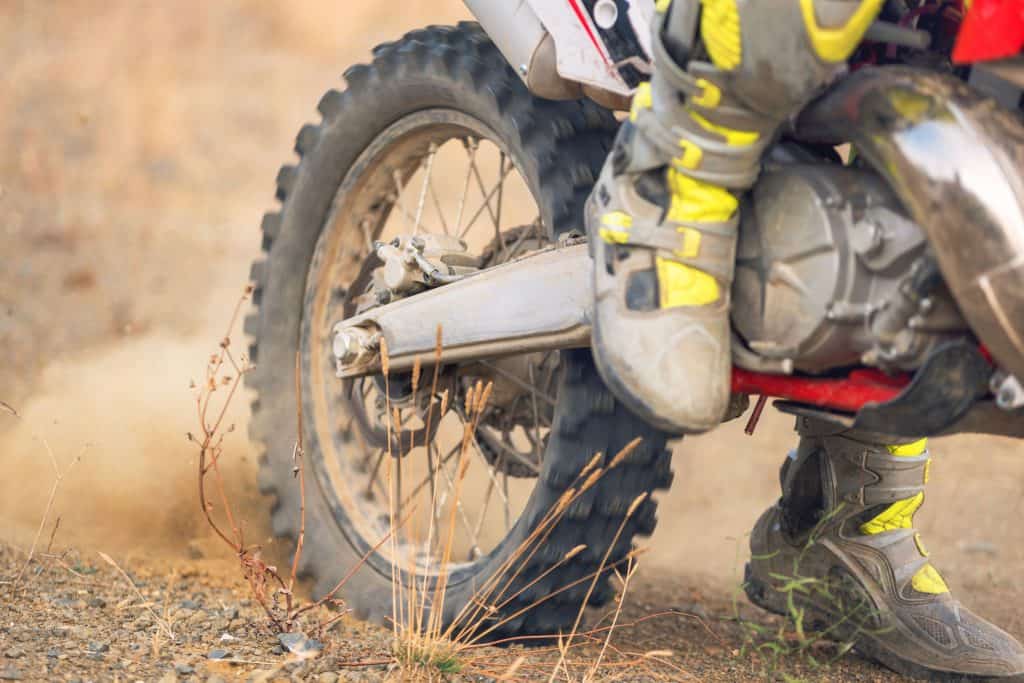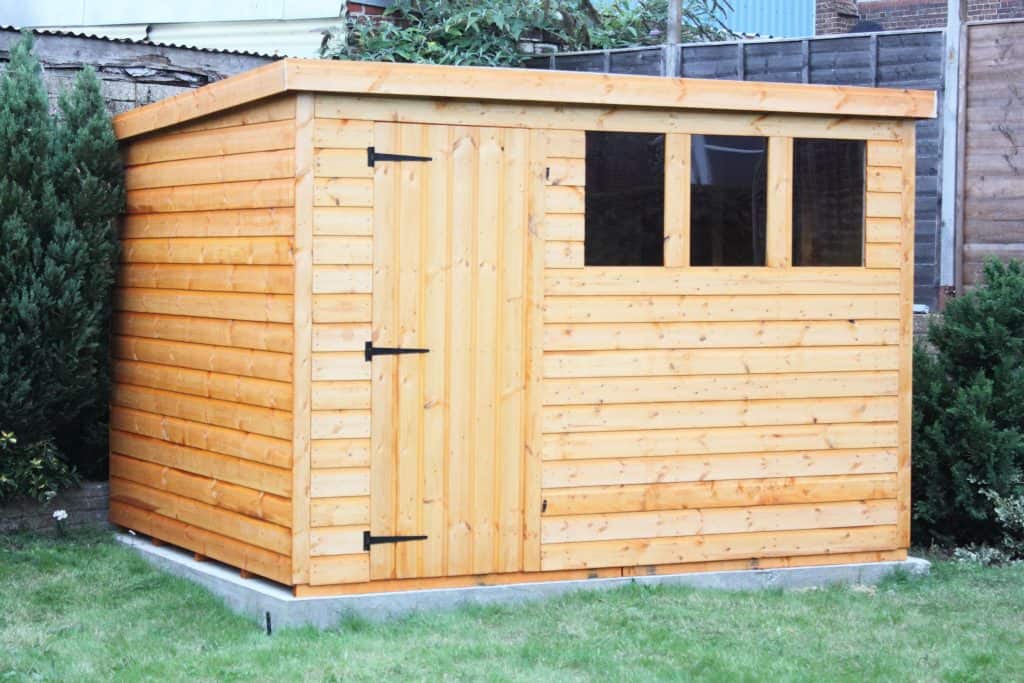
After mixing plenty of fuel for various projects, I figured it was time to document how I do it.
Chances are, you spent a lot of money on your 2-stroke dirt bike, so here is a handy chart for your fuel ratios so that you don’t mess it up (with attached PDF so you can hang it up in your garage).
US (Standard)
| Mixing Ratio (Gas:Oil) | Volume of Gasoline | Volume of 2-Stroke Oil |
| 16:1 | 1 US gal. (128 oz) | 8 oz. |
| 20:1 | 1 US gal. (128 oz) | 6.4 oz. |
| 32:1 | 1 US gal. (128 oz) | 4 oz. |
| 40:1 | 1 US gal. (128 oz) | 3.2 oz. |
| 50:1 | 1 US gal. (128 oz) | 2.6 oz. |
| 100:1 | 1 US gal. (128 oz) | 1.3 oz. |
International (Metric)
| Mixing Ratio (Gas:Oil) | Volume of Gasoline | Volume of 2-Stroke Oil |
| 16:1 | 1 liter | 62.5 ml |
| 20:1 | 1 liter | 50 ml |
| 32:1 | 1 liter | 31.25 ml |
| 40:1 | 1 liter | 25 ml |
| 50:1 | 1 liter | 20 ml |
| 100:1 | 1 liter | 10 ml |
Calculating your fuel amounts
This can be tricky, but we are going to break it down really simply.
Most of the time, you are not going to have an even 1 gallon of gasoline. That means you have to do a bit of math. Here is the simplest way to do it:
Step 1: Write down the amount of Gasoline you have.
Step 2: Multiply the volume of 2-cycle oil by the gallons you have.
If you want to make it really easy on yourself, here is an awesome website that does all the hard work for you:
http://www.premixcalculator.com/

The Simple Equation with examples
This can be complicated, but we are going to keep it really simple so that anybody can do it.
The easiest way for those using standard:
Amount of Gas on hand X Corresponding Volume of 2-Stroke Oil = Amount of Oil to add
This is a little complicated, but this is the easiest way in my opinion because you don’t really need to mess with switching gallons to ounces.
Here are some examples:
I have 3.5 gallons of gasoline that I want to convert into 2-stroke fuel for my bike that takes a 32:1 Gas to Oil mixture. I will go to the chart to find the amount of oil required for one gallon of gasoline, which is 4 oz. Then I multiply 3.5 gallons by the amount of oil required per gallon to get how much oil I should add which is 14 oz.
3.5 Gallons X 4 oz/gallon = 14 oz
I have a one-half gallon of gasoline that I want to convert into 2-stroke fuel for my bike that takes a 40:1 Gas to Oil mixture. I will go to the chart to find the amount of oil required for one gallon of gasoline, which is 3.2 oz. Then I multiply .5 gallons by 3.2 oz required per gallon to get how much oil I should add which is 1.6 oz.
.5 Gallons X 3.2 oz/gallon = 1.6 oz
The easiest way for those using metric:
Amount of Gas on hand / fuel ratio = Oil needed
This is a lot easier. Just divide the liters of gasoline you have by the ratio. Like this:
Here are some examples:
I have 2.5 liters of gasoline that I want to convert into 2-stroke fuel for my bike that takes 40:1 Gas to Oil mixture. I will divide 2.5 by 40, which is .0625 liters, or 62.5 milliliters.
2.5 Liters / 40 = .0625 Liters or 62.5
I have .5 liters of gasoline that I want to convert into 2-stroke fuel for my bike that takes 32:1 Gas to Oil mixture. I will divide .5 by 40, which is .0156 liters, or 15.6 milliliters.
.5 Liters / 32 = .0156 Liters or 15.6

Proper mixing procedure
Some basic tools that really help with this process:

- a PFC or portable fuel container. Most people just call these gas cans
- A measuring cup designed for oil, Like this one
- Your desired oil.
Mixing Steps:
- Find a clean Gas can or PFC (portable fuel container) that can hold your desired amount of fuel mixture.
- Label your gas can
- Determine the amount of oil you need with our handy chart above.
- Measure oil with a liquid measuring cup (preferably not the ones you use for food)
- Make sure you only measure on a level surface, otherwise your mixture will be off.
- Pour oil into the gas can first.
- Mix by adding gasoline into the gas can. If you feel like it isn’t mixed well enough, you can shake the can gently to stir
- Fuel up!
The best way to store mixed fuel

Since two-stroke engines aren’t usually something you use every day, storing your gas mixture is a necessity. Mixing more with the proper ratio is a hassle, so generally, people make a decent amount of mixture, or they only make enough to last the day. There is plenty of debate out there about how long fuel can last, but the truth is that it really depends on your situation.
The key is knowing how to make those mixtures last.
Where to store fuel
The best temperature to store gasoline is 55 degrees Fahrenheit or 13 degrees Celsius, and those types of temperatures are only really found in underground cellars or basements.
You probably don’t have access to a space that is perfect for storing fuel mixture, so really what you need to do is find the best spot available to you.
Often people store their gas in a garage or shed. Those places are actually the worst place to store your fuel mixture. They get a lot of temperature variance because they act like a little oven. Anybody who has walked into a shed in the middle of summer knows what I mean. They can get really hot! At night, depending on where you live, the shed will lose all heat and get just as cold as outside. In some situations, it might be better to store your fuel in a shady spot outside.
As much as it seems counter intuitive, it might be best to just bring the fuel inside and store it somewhere out of sight. I realize for most people that’s not possible because of a plethora of reasons.
If you really don’t have a good spot to store you fuel, don’t worry too much. Just don’t let your fuel get too old!
It might be the best solution to just make enough fuel for one day each time you go out. If you have leftover fuel you can generally pour it into your car and be okay, especially if there is plenty of fuel in your car already.
Fuel Stabilizers
Most people are not going to be able to find a spot that is that temperature year round, and therefore need a fuel stabilizer like this one.

Fuel stabilizers make sure that your fuel doesn’t go bad while it is in storage, as well as when it is sitting in your motorbike. It is really important to put some fuel stabilizers in your equipment and run them for a while before storing them for an extended period of time.
Gas can labeling
Once you mix your fuel, it is temping to fuel up and leave, but it is really important to label your gas can with 3 things:
- The date
- The fuel ratio
- What, if any, other additives it contains
Here is an example of a great gas can label:
- March 28th, 2019
- 40:1
- Fuel stabilizer added
A simple piece of duct tape and a sharpie will do the trick. No need to get any more complicated than that.
If you forget to label your fuel, you are in trouble when it comes to adding more. When you have a little bit of fuel in a gas can that has an unknown ratio you need to get rid of it before you can add any more. Just label your gas cans and keep your life simple.
Adding more to a gas can containing a specific fuel ratio is really easy. Just follow the same steps as above and pretend there is no fuel in there. just be sure that you can fit all the fuel you want to add otherwise you have a potential mess on your hands.
How long can a fuel mixture last with a fuel stabilizer? Well, many fuel stabilizers will advertise that it will make fuel last 2 years, but that is in the best conditions. If your fuel is over a year old and has been outside, I would bet that it is bad. If it doesn’t have fuel stabilizer, I would give it 6 months max.
There is plenty of debate about this, and it really depends on what your conditions are and what type of container you have it in.
I put in the wrong ratio, what do I do?
Don’t worry, all is not lost.
The best thing to do is drain your bike or other equipment of all the fuel mixture and start from scratch, but you have other options.
The key here is knowing if you have too much oil or too little.
How to know if you have too much oil:
Too much oil will lead to a lot more smoke than normal. Your bike will not run vary well because oil doesn’t provide power to the engine, only lubricant.
The key here is knowing when it’s too much. As a general rule, it’s always better to have too much oil than too little, so it usually isn’t a big enough problem to warrant draining the entire engine of fuel.
If you have reason to believe there is way too much oil, it is a good idea to drain the engine.
Better safe than sorry.
How to know if you need more oil:
This is really dangerous. Your motor needs oil to run for any significant amount of time.
If your engine is getting crazy hot, it means you need more oil in the mix.
Chances are your engine will overheat. The oil acts as a lubricant and will keep everything moving nicely. If there is not enough oil your engine will stop working and might even seize.
Do yourself a favor and never make the mistake of not having enough oil.
The Oil I Use

There are so many different 2-Stroke Oils on the market, and it can be tough to figure out which one will keep your engine healthy. After some testing, I believe I have found the one that stands out among all others.
Maxima 22916 Formula K2 2-Stroke Synthetic Racing Premix Oil
This Oil may seem like a simple oil, but the key to why its amazing is in the customer experience. Here is a review by a mechanic that I believe sums up most peoples experience with this oil:
I’m sold on K2.
House324 – Verified Amazon Purchase
I just rebuilt a KX65 with 107 of high reving hours. The old top end looked brand new when I replaced it. All the hours were with K2. No measurable wear in the ring gaps after all the hours of hard riding. Maxima K2, 32:1, clean filters, proper jetting and warming the bike before riding is the perfect combination.
Also rebuilt a YZ125 with 80+ hours and also looked great. Power Valves were pretty clean. Lower ends look great and well oiled.
Side note: I recently switched from Echo’s Synthetic blend, to K2 in a 2 stroke leaf blower and string trimmer…Same 50:1 ratio and the engines rev way higher now with K2. They almost sound like different engines after the switch. It’s a surprising difference and must be the reduced friction from the improved oil.
Great performance, clean power valves and protection have me sold on K2.
You really can’t argue with that. If you don’t believe me, go check out peoples reviews yourself.
Out of all the different oils out there, I am the most confident that this one will keep your bike in pristine condition.
What does running lean or rich mean?
In order to understand this, it’s best to understand how a two stroke engine works. Here is a video that shows how a two stroke engine works:
So a two stroke engine is a lot more simple then a four stroke engine. Every time the piston moves up, it ignites and provides power. In a four stroke, the piston would move up again to clear out exhaust. That is why 2 strokes are so noisy.
So what is running rich vs lean in a two stroke?
In terms of oil, running rich means that you don’t have enough oil in your fuel. Running lean means that you have too much oil.
This may seem a little backward if you are unfamiliar with engines, but all that rich or lean means is that there is too much or too little fuel for ignition.
Oil Injection vs Premix: which one is better?
This argument has been heated among dirt bike enthusiasts for a very long time, and there really isn’t a simple answer. I wish there was.
Premix is what we have talked about in this article, which is an oil-gas mixture that you put directly in the tank. Oil injection requires a system that injects the oil inside the engine.
The problem with arguing this is that everybody has their own experiences with both and may blame one or the other for their trouble with their bike.
Personally, I am a fan of premix just because its simpler. You mix the oil and gas beforehand, and you don’t have to worry about another part failing. Injection systems can clog because of cold weather, or even have trouble right when you start your bike, causing your bike to run rich.
2 strokes are super great because of how bare bones and powerful they are, and I would hate to add another part to it all. That being said, some people swear by their injection systems, and you can’t condemn them for it.


